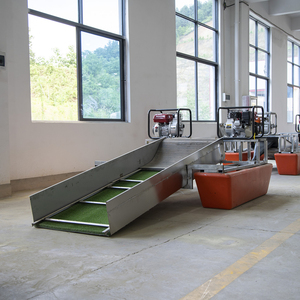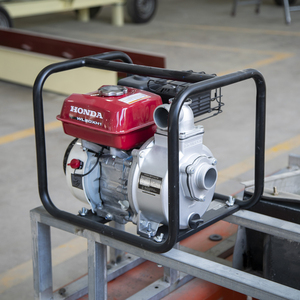
All categories
Featured selections
Trade Assurance
Buyer Central
Help Center
Get the app
Become a supplier

(767 products available)












































The Keene gold dredge is a set of underwater suction tools used to extract gold from rivers and creek beds. Depending on how they work, they can be classified into three main types: air-emission-driven suction nozzles, diesel or gasoline pump dredges, and electric pump dredges.
Aird Compressor-driven Dredge
This type of dredge is usually powered by a portable air compressor. The dredge operates on the same principle as a vacuum cleaner, which sucks in air and extracts particles of sand and gravel of varying sizes. The dredge nozzle, connected to a flexible hose, sucks in underwater material, including gravel, sand, water, and, possibly, gold. Compressed air within the nozzle then splits the material into finer parts that it releases back into the water, trapping any gold particles in the sluice box. An air compressor provides breathing air to the diver working at the dredge site. This enables the diver to work underwater for longer periods, which in turn improves the dredge's efficiency in locating and extracting gold-bearing material.
Gasoline or Diesel Pump Dredge
The Keene diesel gold dredge or one powered by gasoline pump energy is easily recognizable due to its heavier weight, large size, and separate sluice box. This kind of dredge is designed for more extensive mining operations and used in areas where gold is plentiful. Like the air compressor-driven dredge, this dredge type uses suction to draw in underwater material through a nozzle connected by a hose to a water pump. The material is introduced into a diver-assisted mining system or sluiced through a separate sluice box for immediate analysis. However, the operational principle for providing water pressure and circulation is different. A gasoline or diesel-powered water pump provides the necessary water pressure and circulation to flush out material from the bottom of a river or stream bed. The operator must ensure that a consistent water supply is maintained by the water pump to ensure proper operation.
Electric Pump Dredge
The Keene electric gold dredge is lightweight and compact, making it ideal for easily-accessible gold-bearing locations. Although it works like the gasoline-powered dredge, an electric submersible water pump provides the water pressure and circulation to flush out materials. Specifications include a 12-volt battery and an 8-inch suction nozzle. Because an electric pump powers the gold dredge, it is restricted to shallow water and areas where access to electrical power is possible.
Specifications are essential to know the differences and uniqueness of each dredge. Matching a dredge's specifications to the job at hand is vital, and only a knowledgeable operator can understand the dredge's workings.
Each dredge must be checked carefully and thoroughly before operating to ensure all components are functional and able to be utilized safely. The pump is the main part of any core drill setup, but there are other important parts that should not be neglected.
Jet-drive dredges work on the same basis as the dredge pumps outlined but utilize a different method of propulsion.
Gold-producing regions of North America include, but are not limited to, the following:
Extra care should be taken after dredge mining has been carried out in order to ensure that no habitat was destroyed and that any material required to be left behind is safely out of the way.
As stated earlier, gold dredges work pretty much like natural river systems. They are designed to extract gold from riverbeds, gravel, and sand, which makes them useful for prospecting within river bodies. The use of gold dredge machines is not limited to just this; many industries make use of this mining machine.
Here is a list of several use cases and scenarios where gold dredge machines can be found useful.
When buying a gold dredger for sale, buyers should consider the following factors to attract more customers.
Suitability for specific gold deposit locations
Different areas of the river have varying sedimentation characteristics. For instance, shallow waterways with sand or gravel beds are more likely to contain gold deposits. A low-pump-power dredge would work well in such a river location. Buyers should consider how well a dredger will perform in a certain river environment.
Ease of use and transportation
A well-designed dredge is lightweight and compact so that the gold miner can easily put it together or take it apart for transportation. The dredge should also have user-friendly controls that an operator can easily understand and master to work efficiently and accurately.
Customer demand for fuel
Gold dredge operators desire equipment that uses fuel efficiently. Operators who mine in locations far from main roads need to be especially concerned about fuel consumption. A dredge that uses less fuel will enable the operator to realize a higher profit margin when mining for gold.
Durability against harsh mining conditions
A gold dredger will certainly face demanding conditions when used to extract gold from river beds. Constant submersion in water, exposure to corrosive elements, and continuous operation against tough geological formations all take their toll. Buyers should look for a dredger with durable parts, such as thick hoses, abrasion-resistant commutators, and high-quality, long-lasting pump bearings.
Operator and customer support
Some quarry operators or gold-mining customers will want to know the manufacturer's or supplier's customer support. Do they get timely spare parts when something goes wrong with the dredge? Will the technicians offer assistance on how to operate and get the best performance from the dredge? A supplier with a good support network will give buyers some assurance that their customers will be well taken care of.
Q: How does a gold dredge work?
A gold dredge works by creating a fluidized bed of material on a sluice box or extractor using certain chemicals. Then, a submerged gold mining pump draws the slurry of material and water into itself. After that, the material will be transferred to a processing plant or a sluice box for separation and filtration.
Q: What are the main components of a gold dredge?
The main components of a gold dredge include a floating platform, suction assembly, sluice boxes or shaking tables, a centralized control room, and a propulsion system. The entire dredging operation is managed, monitored, and controlled from a centralized control room. Some gold dredges may also be equipped with accommodation facilities for crew members.
Q: What is the difference between a gold dredge and a gold dredger?
A gold dredge is a machine used to excavate gold, while a gold dredger refers to either the person operating the machine or the vessel on which the gold dredge is located.